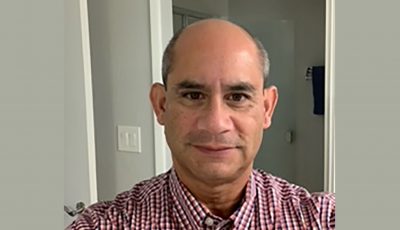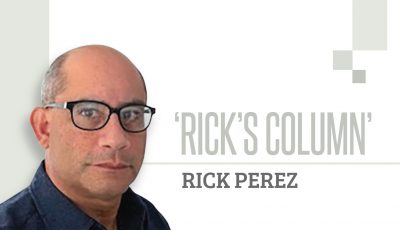RICK’S COLUMN
Circumnavigating Saipan captures essence of traditional navigation
For those of us who previously served in the U.S. military, our job has been to directly engage in a variety of capacities, work that contributes to the overall protection and security of the United States and its interests worldwide. This line of work requires all kinds of substantial resources and the need to work with different organizations and people to accomplish the stated goals.
The national security and military fields, however, are not unique when it comes to working toward a common goal or mission set because similar principles apply to the work performed on the development of the ancient maritime practices and industry that is resurfacing after being dormant in the Marianas Islands for centuries.
The recent circumnavigation of Saipan using vessel designs of ancient Chamorro canoes provides one example of how unity of effort, having a clear mission, and working from the heart can transform and resurrect our ancient canoe building practices.
When individuals demonstrate teamwork, transformation occurs
As most of us already are aware, four Chamorro canoes recently embarked and completed a historic maritime journey circumnavigating Saipan. Four master navigators of Carolinian descent led the way. The idea to conduct a circumnavigation was reportedly made by master navigator Cecilio Raikiulipiy, who also according to 500 Sails, was a co-author of the Lakayak Sailing Manual and instructor for the selected crew.
Principal leaders and pathbreakers such as Pete and Emma Perez from 500 Sails, along with their paid staff and volunteers, provided logistical, communications, community, and facility support throughout the preparation and actual participation stages of the circumnavigation trip. Mario Borja, who has and continues to be instrumental in engineering, designing, and constructing Chamorro canoes, actively contributed to the circumnavigation effort in a variety of ways.
The overnight voyage was executed using the following four named canoes: Neni, Auntie Oba, Richard Seman, and Anaguan. Master navigators involved (forgive me for any name misspellings) were Mau Piailug’s son, Sesario Sewralur, Antonio Piailug, the brother of Sesario Sewralur, nephew Cecilio Raikiulipiy, and Mariano Bonito.
How working together translates into Pacific Island security at the local level
This unity of effort to resurrect and demonstrate Chamorro and Carolinian ingenuity, creativity, hard work, and passion represents the pursuit of excellence stemming from the Pacific Islander talents rooted in the deepest parts of the Deep Blue Ocean continent. Several aspects make this endeavor most consequential by many units of measure. One measure is that our ancient maritime traditions and practices, previously stripped from our Chamorro people several centuries ago through European exploitation and colonization, have been rebirthed.
The confluence of Chamorros from Guam and the Northern Marianas interested in maritime adventures, leadership, and mentorship from Carolinian master navigators, interested community members, and 500 Sails, represents a world-class, uncommon, and most unique shared sense of the pursuit of enduring excellence in union with the Deep Blue Pacific Sea. This unity of effort is tied to our ancient Pacific Islander historical narrative that dates back several thousands of years. It is a tradition we own as Chamorros, Carolinians and Pacific Islanders, because these Mariana islands are our collective homes.
Collaboration was also found through the 500 Sails Cultural Maritime Training Center’s Traditional Navigation Track program. The center’s ability to operate is due in part to the support it has received from the Administration for Children and Families, a division of the U.S. Department of Health and Human Services. Funding was provided by the Administration for Native Americans’ Social and Economic Development Strategies, Chamolinian Cultural Village Inc. – Canoe Federation, the CNMI Office of Indigenous Affairs and private sector supporter IT&E.
Real-time challenges at sea
As many are aware and as 500 Sales can attest, during the first leg to Unai Bapot (Laulau), three of the canoes needed a tow by the escort boat to ensure they arrived before dark. The crew on these canoes got to learn about how to get towed, including where to connect lines so the canoe was as stable as possible, what knots to use to ensure a proper tow was possible, and where to put the weight on the canoe. One canoe was able to sail completely around Saipan without assistance. No one was towed during the second leg, from Unai Bapot to the Guma Sakman in Susupe.
Pacific Islander leadership securing Deep Blue Continent island security for generations to come through ocean-based transportation knowledge
Traditional navigation requires a deep understanding of significant star formations, being intimate with weather and swell patterns, and understanding all phases of the moon and tides.
This represents a deep security, one not predicated on a superpower adversary or nation state enemy, but rather a security rooted in Deep Blue Ocean continental knowledge, a deep-seated sense of Pacific Islander unity of effort and camaraderie and, most of all, a shared maritime-based love of a very rare and geographically unique part of the world.
Concluding thoughts
World-class traditional navigation security is found on Saipan Island. Saipan is home to several of the world’s most experienced master ocean navigators. World-class foresight and persistence to actualize our ancient Pacific Islander culture has been and continues to be found in the Northern Marianas Islands.
The significance of this maritime effort through circumnavigation can also be seen from the standpoint that at any moment a crew member or navigator could have died during the trek. Thus, the execution and completion of this undertaking represents a security deeply embedded in our hearts, minds, and souls of the families of those of Carolinian and Chamorro ancestry.


























